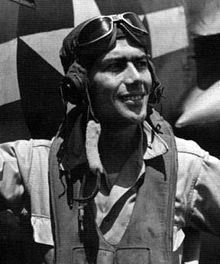Years of service 1941 – 1945 Died 7 October 1945 | Rank Colonel | |
 | ||
Born June 23, 1920
Kenmore, Ohio ( 1920-06-23 ) Allegiance United States of America Service/branch United States Army Air Corps
United States Army Air Forces Unit 54th Pursuit Group
329th Fighter Group
49th Fighter Group Commands held 9th Fighter Squadron
49th Fighter Group | ||
Gerald R. "Jerry" Johnson was a World War II Flying ace who flew for the United States Army Air Forces. He ended his war career with 22 kills and was awarded with the DSC, DFC, Silver Star, Air Medal, and Legion of Merit.
Contents
Early career
Johnson was born in Kenmore at Ohio on 1920.
In 1941 he joined the U.S. Army Aviation Cadet Program at Luke Air Force Base. He received his Pilot Wings in the fall of 1941 and was commissioned a 2nd Lieutenant. He was then assigned to the 54th, Fourth Fighter Group of the Eleventh Air Force where he flew the Bell P-39 Airacobra and Curtiss P-40 Warhawk. In Alaska, on fifty-eight air combat missions he scored two enemy aircraft kills while flying the P-38 Lightning.
South Pacific Career
Johnson was then moved to Australia and was assigned to the 49th Fighter Group of the Fifth Air Force. During one mission, while piloting a P-38 Lightning, he and other aircraft from the 348th Fighter Group intercepted twenty Japanese aircraft. As they maneuvered into position, one of the aircraft in Johnson's formation could not drop its auxiliary fuel tanks, while another blew a supercharger. Unable to fight effectively these aircraft were escorted back home leaving Johnson and a few other aircraft alone.
During the dogfight, Johnson chased an enemy aircraft off his wingman's tail and destroyed it. Johnson's aircraft was then attacked by the enemy. His heavy fire tore the wing off a Japanese fighter and sent it spiraling, in the process ripping off Johnson's port (left) tail boom assembly. Johnson managed to regain control of his aircraft and was escorted back to base by the remaining friendly planes. He scored three victories that day, but at the cost of his own aircraft. Johnson was promoted to Captain in the 9th Fighter Squadron in August 1943.
While providing an escort for B-17 Flying Fortresses bombers, Johnson scored another kill when a Japanese aircraft, concentrating on the bombers, flew straight into his line of fire. Opening fire, he quickly swooped behind another enemy aircraft and sent it down in a ball of flames. In October, Johnson was promoted to the rank of Major.
Three more victories brought him to a total of twenty kills, a quadruple ace, and he was promoted to the rank of Lieutenant Colonel.
Death
A few weeks after World War II ended, Johnson was flying a B-25 Mitchell when it flew into a typhoon. He gave up his parachute to allow the other crew members to bail out of the aircraft, while he and the co-pilot attempted to guide it back to the airfield. The two men went down with the plane and were killed.
Lt. General George C. Kenney, commander of the Fifth Air Force during WWII, told Johnson's father: "You are the father of the bravest man I ever knew and the bravest thing he ever did was the last thing, when he did not need to be brave."
Awards and Decorations
His awards and decorations include:
USAAF Pilot Badge
